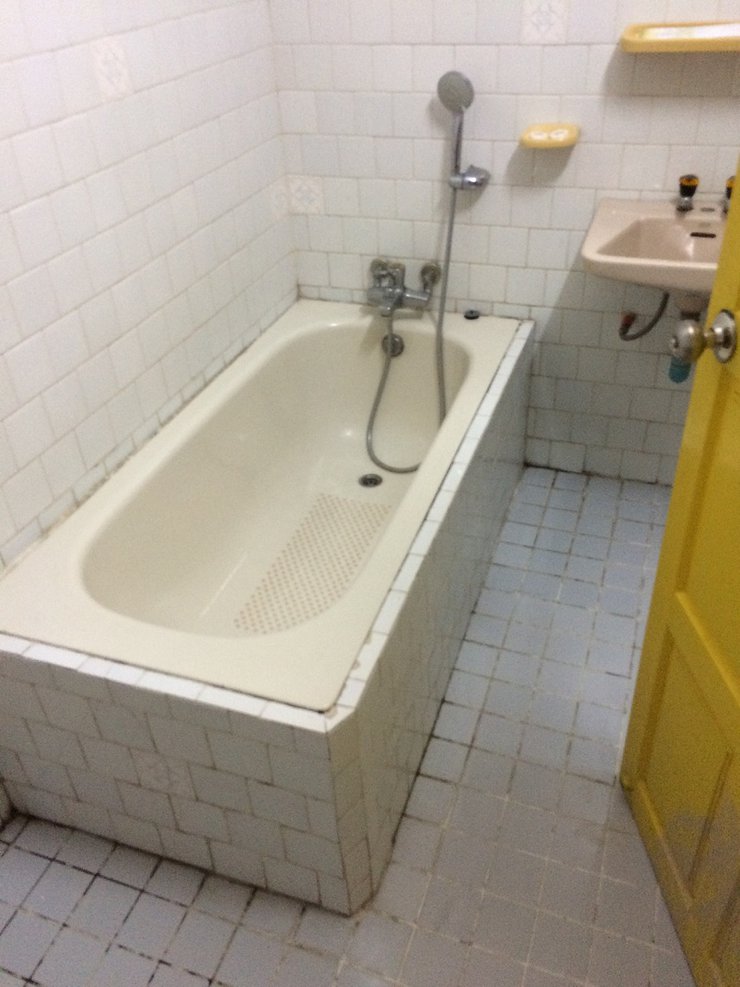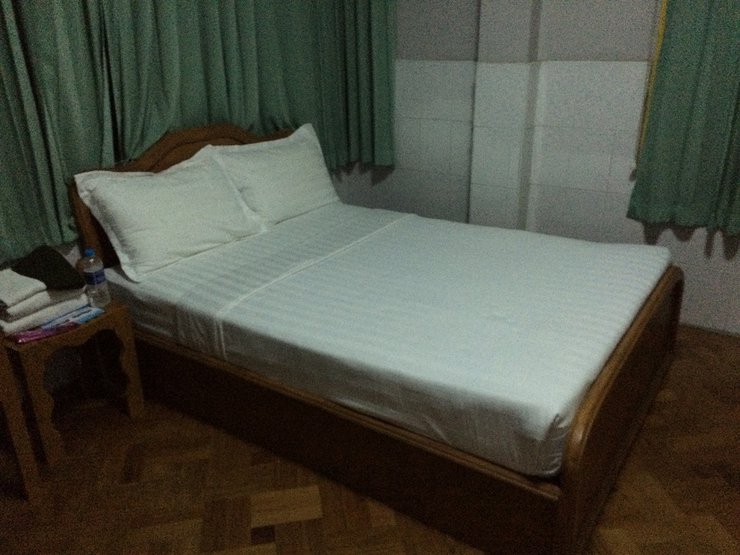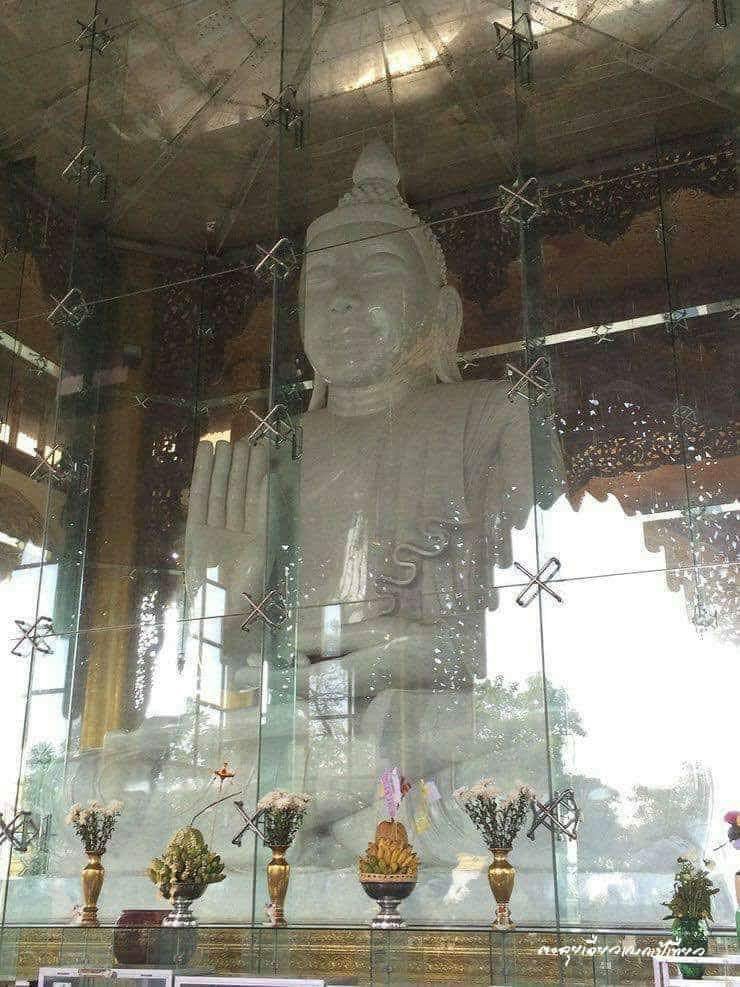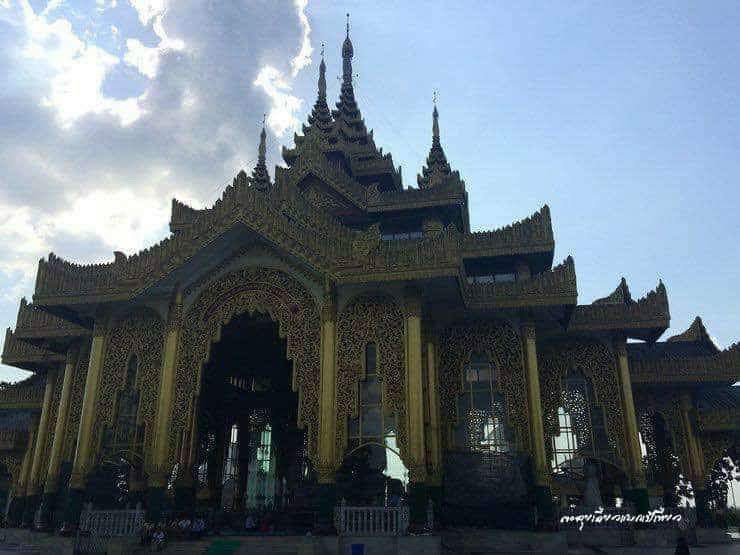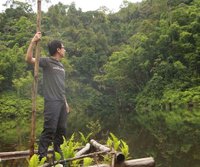From December 11th to 15th, 2014, I embarked on my second trip to Myanmar. My primary goal was to visit the U Bein Bridge in Amarapura, the world's longest teakwood bridge. The remaining sights were a bonus. All photos were taken with a mobile phone.
This trip was booked with AirAsia a long time ago, almost to the point of forgetting. Departing from Don Mueang, AirAsia departed on time at 11:35 AM and arrived in Yangon 15 minutes early. This time, the plane was parked far away, requiring a considerable walk. After clearing immigration, I checked the exchange rate to exchange money. This time, the rate was 1$ = 1,032 kyats, better than the previous rate of 1$ = 970 kyats. I exchanged a total of $200 this time, thinking that I would need to travel further and not have to worry about finding another place to exchange. After exchanging money, I went to buy a SIM card at the airport. There was a booth for Telenor, but it was closed until noon, ignoring customers who had just arrived. As I walked out, it was the same as before, taxis swarmed me. I chose to walk away from the group and opted for a non-airport taxi. I chose City Taxi, which was easier to negotiate with. I hired them to take me to buy a ticket at the bus station, tour Yangon for half a day, and return me to the bus station before 7 PM. 6 hours for 20,000 kyats (the usual fixed price is 5,000 kyats per hour). Joe Jo, the taxi driver, took me to buy a ticket from a local company to Mandalay for 10,600 kyats.

We asked Jojo for a SIM card to access the internet. He directed us to a nearby store. We inquired about the best network provider, and the owner recommended Ooredoo (pronounced "O-re-doo") over Telenor. We opted for Ooredoo, which charges 10 kyats per minute for local calls and 200 kyats per minute for calls to Thailand.
The next stop was the Kyauk Taw Gyi Buddha Temple, also known as the White Jade Buddha Temple or the White Stone Buddha Temple. The 11-meter-tall Buddha statue is carved from a single piece of stone and weighs 600 tons. The statue depicts the Buddha in a seated position, with his right hand holding a relic brought from Singapore and Sri Lanka. The left and right footprints of the Buddha are displayed behind the statue, made from the leftover jade from the statue's construction. The statue was built during the time of General Than Shwe, when a large piece of jade was discovered in Rakhine State. The jade was sent to Mandalay to be carved and then brought to the temple, where it is kept in a temperature-controlled room to prevent the jade from cracking.



Next, we visited the Kaba Aye Pagoda, a serene and less crowded site. We observed numerous Burmese people performing religious rituals. The pagoda, with its five entrances, boasts a circular design. It was constructed by U Nu, the first Prime Minister of Burma, as a venue for the purification of the Tripitaka.




As soon as we left the temple, we stopped by the restaurant next door because we were hungry. After we sat down for a while, the owner's son played some Thai music for us. Then he turned on a Thai-Burmese boxing match. We ate while watching the boxing, which was a different kind of fun. This meal cost 2,000 kyats and was full of vegetables. As someone who doesn't like vegetables, I had to eat them, but they were actually quite delicious.

After satisfying our hunger, Jojo bought us some water to drink, telling us to stay hydrated as it was hot. Leaving the restaurant, we continued our journey to the Botahtaung Pagoda, where the entrance fee was $3 and we were required to leave our shoes in the ticket office. This pagoda is known for its "Nats" (spirits), which are particularly popular among Thai worshippers. We simply took some photos and left, as Jojo seemed to sense my lack of interest. He then led us to explore other parts of the pagoda.




We arrived on a day when there was a temple fair, but the stalls were not yet set up (the road was not yet closed). We told Jojo that we wanted to see the Yangon River, so he took us for a walk along the waterfront. The air was very good, and we also saw the sunset here. We really liked this spot.

It was almost 6 pm when we rushed out to the bus station to catch a bus to Mandalay. The traffic in Yangon was very bad, and we were both worried. Jojo got us there 10 minutes before the bus was due to leave. The bus conductor complained that we were late, but Jojo sorted everything out and even put our bags away for us. We exchanged numbers and told him we would call him when we returned to Yangon. We then slept all the way to the place where we stopped for lunch, and then slept again until we reached Mandalay.
At 5 am, the car arrived in Mandalay. As usual, there were taxis and motorbike taxis waiting for customers. We decided to walk past them first to get our bearings. The first thing we needed to do was book a ticket back to Yangon, as we planned to continue to Bago. On the way back, we got a ticket from Mann Yar Zar Express for 10,800 kyats, which was 200 kyats more expensive than the way there. A young boy offered to take us to see the sunrise at U Bein Bridge and then drop us off at the East Mandalay Hotel for 10,000 kyats. We agreed to go with him (I can't remember his name, but I later found out that he was still in school and was riding a motorbike to take tourists around to earn money for his studies). He took us to his motorbike and looked after our bags, then we rode to Amarapura to catch the sunrise. It was quite cold on the way, only 15 degrees Celsius. Finally, we arrived, and there were many people waiting to watch the sunrise. We decided to walk on the bridge and enjoy the pleasant atmosphere.
The U Bein Bridge, constructed from teak wood, spans the Taungthaman Lake with a length of 1.2 kilometers. It is renowned as the world's longest teakwood bridge. However, a portion of the bridge in the middle of the lake has been replaced with concrete pillars and structures.



After a leisurely two-lap walk, enjoying the scenery until after 7 am, I decided to return to the motorbike driver. Feeling hungry, I followed him to a small lakeside restaurant where I ordered noodles and coffee for breakfast, costing 1,300 kyats. The driver then asked for my desired itinerary, offering several suggestions. However, due to the 9 am departure for Mingun, I requested a direct trip to the hotel. After checking in, I rushed back to the driver for a ride to the Mingun jetty. We agreed on a full-day fare of 20,000 kyats. Upon arrival, I purchased a round-trip boat ticket to Mingun for 5,000 kyats. The driver agreed to pick me up at 1:30 pm.


A 1.5-hour boat ride on the Irrawaddy River (with a chance for a nap) takes you to Mingun village, where the unfinished Mingun Pagoda awaits. This colossal structure, if completed, would have stood at a staggering 152 meters tall and 150 meters wide, making it the tallest pagoda in the world. Even the unfinished lions guarding the entrance are massive, hinting at the sheer scale of the intended project.
King Bodawpaya ordered its construction between 1790 and 1797. If completed, it would have been a massive pagoda. However, it was left in ruins due to the earthquake of 1838.


Upon reaching the summit, local student guides offered their services. The students requested 5,000 kip to purchase school supplies. The view from the top was beautiful.

Upon descending, we entered the pagoda to pay respects to the Buddha statue. We were then asked to pay a 3,000 kip "land tax." Everyone had to pay upon arrival, but we had wandered around the upper level first.

Next, we visited the Mingun Bell, the world's largest functioning bell, after the Tsar Kolokol bell at the Ivan Veliky Bell Tower in the Moscow Kremlin, Russia, was cracked.


Continuing on, you will encounter the Hsinbyume Paya, also known as the "Taj Mahal of the Irrawaddy River".
The Shwe Inn Thein Paya, also known as the Myay Tein Tan Pagoda, was built by King Bagyidaw in 1816 to commemorate his queen, Princess Shwe Inn Thein. The design of the pagoda is inspired by Mount Meru, with seven surrounding hills. The stupa is surrounded by niches containing figures of mythical animals that serve as guardians.



We ate at a nearby restaurant, but the prices were outrageous. A bowl of beef noodles and a can of Coke cost 3,500 kyats.

The sentence is already in English and does not require translation.
It's almost time to return. Let's hurry back to the pier and wait. The return trip takes only 40 minutes by boat. When we arrive, our guide will be waiting for us. Our next destination is the Mandalay Palace. The entrance fee is 10,000 kyats, or $10. We will visit the palace, which was rebuilt after being destroyed by British bombs during World War II.
The Mandalay Palace was built by King Mindon between 1857 and 1859 after the capital was moved from Amarapura to Mandalay. It is known in Burmese as မြနန်းစံကျော် (Mya Nan San Kyaw), which means "The Emerald Palace of Great Renown", but is better known as ရွှေနန်းတော်ကြီး, meaning "The Great Golden Palace". It is a palace built entirely of teak wood and is considered one of the most beautiful in Asia. It has a moat around the palace and a grand gate. It was the last palace of King Thibaw, the last king of the Konbaung dynasty and in Burmese history. When the British occupied Burma during World War II, they thought the palace was a gathering place for Japanese soldiers, so they destroyed the palace by bombing it from airplanes on March 20, 1945. The palace has been in ruins ever since, but is now being restored by the Burmese government, using the original structure as a model. It is one of the most important tourist attractions in Mandalay.




After exploring the newly constructed palace, my companion and I visited the Shwenandaw Monastery, using the same pass as for the Mandalay Palace. The Shwenandaw Monastery was originally the royal palace of King Mindon, who relocated it from Amarapura, the former capital, to the newly established capital of Mandalay.
The king used this palace as a place for meditation and to sit in meditation. Finally, he died here. Then, King Thibaw, his son, moved the palace from the Mandalay Palace to this temple, which is now the Shwenandaw Monastery or Golden Palace Monastery.



The Kuthodaw Pagoda: A Monument to the Fourth Buddhist Council
The Kuthodaw Pagoda, located within the grounds of the Maha Lawka Marazein Monastery, is a testament to the Fourth Buddhist Council held in 1857 under King Mindon. This magnificent structure houses the world's largest inscribed collection of the Pali Canon, etched onto 729 marble slabs.
King Mindon commissioned the inscription of the 84,000 teachings of the Buddha, marking a significant milestone in the preservation and dissemination of Buddhist scriptures. This monumental undertaking not only produced the largest physical copy of the Pali Canon but also established it as the official language of the scriptures for the first time in history.
The inscribed slabs are housed in individual whitewashed pavilions surrounding the central Maha Lawka Marazein Pagoda, a 30-meter-tall structure inspired by the renowned Shwezigon Pagoda in Bagan. This architectural marvel stands as a symbol of the enduring legacy of the Fourth Buddhist Council and the unwavering dedication of King Mindon to preserving the Buddha's teachings.



Continue to Kyauktawgyi Temple (Kyauktawgyi Temple) to worship the marble Buddha statue built by King Mindon. Kyauktawgyi Temple, or as the Burmese call it "Tongtamonjoktokyi", is over 250 years old. The highlight of this temple is the main Buddha statue in the Konbaung period of Burmese art, which is beautiful and perfect according to Burmese Buddhist art in every way. And there are murals that Thai tourists may find very familiar. Because it is a beautiful and harmonious blend of Thai art.


The energy was still high, so we continued our adventures by climbing Mandalay Hill. It's better to say that we walked up the stairs. It was quite a climb, but it was a lot of fun. Cars can almost reach the top, but our guide wanted us to experience everything to the fullest. Along the way, we saw many things and had a lot of fun. When we reached the top, we were also able to watch the sunset.





After descending the mountain, my guide escorted me to the hotel and arranged to meet me at 4:00 AM the next morning to witness the Mahamuni Buddha's face-washing ceremony. We settled the payment for the first day, and my guide informed me that she would deliver the money to her mother. As I had barely seen the room earlier, I took this opportunity to examine it more closely. The East Mandalay Hotel, which I booked through Agoda for a special 50% discount, cost $25. Additionally, the hotel upgraded my room upon realizing I was traveling alone. The room was in excellent condition, clean, and even had a bathtub.


After taking a shower, I went out to explore the Mandalay Palace. There were many Burmese people jogging and exercising. There were exercise machines in several places. If you are looking for food around the palace, there are many restaurants to choose from. You can choose to eat whatever you like. The price is usually 1,000-1,500 kyats per dish (I didn't take any pictures because my phone battery was dead). In the evening, the Mandalay Palace is beautiful and the weather is cool and comfortable.
This morning, we had to attend the Mahamuni Buddha's face-washing ceremony. We set the alarm for 3:30 AM, but it was so cold that we only had time to wash our faces and brush our teeth before rushing downstairs. Our friends were already waiting for us, and we rode our motorbikes to the temple. It was quite crowded, mostly with Thai tourists. As 4:30 AM approached, the abbot arrived, and people began offering him gifts.

As the temple doors opened, we moved to sit next to the Burmese pilgrims to witness the face-washing ceremony. The ceremony began with the monks covering their faces with cloth. They then cleaned their mouths, resembling brushing their teeth, followed by washing their faces. By the time the ceremony concluded, the Burmese pilgrims had left, leaving only Thai people waiting until the end. The water used for washing the face was brought in a jug. We saw the Burmese pilgrims scoop the water and sprinkle it on their heads, so we did the same. Some people might have brought cloths to have the officials wipe the Mahamuni Buddha's face. We did not take videos out of consideration for the people behind us, who would have been obstructed by our hands. Instead, we opted to take still photos periodically. (We were sitting in the enclosure in front of the door, with many people still behind us.)



Men are allowed to enter and apply gold leaf. We walked to buy gold leaf prepared by the temple and queued with Burmese people. Photography is not allowed on the upper level. After applying gold leaf, we went down to take photos before leaving the Mahamuni Pagoda.

After the ceremony, my friend dropped me off at the hotel. We agreed to meet again at 8 am. I returned to my room to pack my bags, went downstairs for breakfast, and then went back up to shower. However, the water wasn't working. The staff tried to fix it, but it wasn't fast enough for my needs. I had planned to visit several places that day, and they were all outside the city, so I decided to check out of the hotel.
Upon arriving, we encountered our companion who had switched to a new motorcycle, explaining that their previous vehicle was unreliable for the long journey ahead. The replacement was their mother's motorcycle. This morning, they took us to the Shwe In Bin Kyaung temple, a magnificent structure renowned for its intricate woodwork and Buddha statues. The temple was constructed in 1890 by a Chinese jade merchant.




After admiring the temple, the motorbike wouldn't start. The young man couldn't kick-start it, so he had to ask someone for help (we didn't know how to kick-start it either). As we rode away, we started to leave the developed area of Mandalay. The roads were in poor condition, with many potholes. However, if we had taken a taxi, we wouldn't have come this way. After a while, we arrived at a place where Buddha statues were being made. We watched for a while as they worked quickly. The young man told us that the prices here were cheap and there were many shops to choose from.

Before continuing, my younger sibling asked if we wanted to stop by the puppet workshop, which also sells other wooden crafts. We immediately said yes, as we love the puppets there (we bought four last time and two large ones this time, although not from this shop).

We then continued our journey to arrive in time for the midday meal at the Mahagandayon Monastery, the largest monastic school in Myanmar. There is a corner where you can buy offerings for the meal, or you can join the temple in offering. I saw Thai tour groups bringing offerings from Thailand to participate in the meal.
Prohibitions (remember a little)
- No loud noises (many people fail to do this)
- Do not walk in front of the procession of monks and novices (some people walked in front to take pictures).
- Avoid inappropriate behavior when taking photos (I've seen some people doing it).



If you are visiting this temple, please bring food for the dogs there. They are extremely thin, with their skin and bones visible. We tried to find food nearby, but there was nothing available except for religious books and offerings.
After leaving the temple, we continued on to Sagaing. On the way, we stopped to take photos before crossing the bridge to Sagaing.


The younger sibling suggested we climb Sagaing Hill ourselves, taking 2-3 hours to explore the temples and views.






Climbing down to the bottom, I complained to my younger sibling that I was hungry. They said they would take me to eat at the port in Inwa. We rode back across the bridge and turned onto a path shaded by trees. I really like this road, it's so green. (The picture is a bit shaky, taken while the motorbike was running)

Upon arriving at the Angwa Pier, we found only one restaurant (thinking to myself, this is going to be expensive). I invited my friend to join me for lunch, and she said she would take care of everything. We ordered fried rice with pork, pork curry, and Coke. Eavesdropping on the table next to us, I heard two Chinese women order noodle soup and Coke for 3,000 kyats. Our order was even larger. As we neared the end of our meal, they brought us a plate of watermelon (thinking to myself, I guess they're going to charge us a lot, but at least they're giving us a complimentary dessert). When the bill came, it was only 3,500 kyats. Wow, that's much cheaper than I expected.


If you're planning to visit Inwa, be sure to have lunch at this restaurant, as they offer free meals to all drivers. Once you're done, it's time to cross over to Inwa. Pay the boat fare at the booth on the right before heading down to the pier. Upon arrival in Inwa, you'll find numerous horse-drawn carriages waiting to offer their services. The cost for a two-hour ride is 5,000-6,000 kyats. We opted for a motorbike instead, as we were pressed for time, and settled on a price of 4,000 kyats.
The First Stop: Maha Aung Mye Bonzan Kyaung
The first stop on your journey through Inwa Island is the Maha Aung Mye Bonzan Kyaung. This monastery shares the same entrance ticket as the Mandalay Palace, so be sure to hold onto it!




We then rode on to the Leaning Tower of Ava. It really is leaning; we didn't take the photo at an angle (although we usually like to take photos at an angle).

The sentence is empty.

After finishing the meal, we went outside and realized the motorbike was gone. We were confused and didn't know where it went. A vendor told us to wait, and the owner would return. When he did, we continued our journey to the Yadana Sinme Monastery.


This is a beautiful spot. I love it the most.

Continuing on to Bagaya Kyaung, we found children and novices studying scriptures upon our arrival. Silence was observed by all. The temple grounds feature a pavilion adorned with intricate carvings in the Ava style.



The sentence is already in English and does not require translation.
The motorbike driver then gave us an additional stop at the Daw Gyan Pagoda Complex.



It was 4 pm, time to cross the river again. The motorbike driver told us that he would take us to see the sunset at U Bein Bridge again, so we had to hurry. We drove back to the bridge and the driver stopped for us to walk. On Saturdays and full moon days, many Burmese people and monks come out to walk and relax on the bridge. It was a lot of fun. The driver knew that we liked U Bein, so he took us to see both the sunrise and sunset.



We then stopped for dinner at the same noodle shop, but this time the owner was kind enough to give us a lot of extra toppings and let us charge our phones for free (all shops and bus companies offer free charging). After we were full, my friend dropped me off at the bus station. He told the bus company staff that I needed to take a shower (I was the only one who asked to shower there). I paid 25,000 kip for the tour and gave an additional 5,000 kip for the excellent service. As soon as the bus left, I fell asleep because I was so tired.
The bus arrived at Yangon's bus station at 5:00 AM. I intended to travel to Bago, but the only available buses were non-air-conditioned and expensive (4,000 kyats). I decided to take one anyway to avoid walking. After an hour of sleep, I felt refreshed. I remember the journey taking 2-4 hours, but I couldn't recall which bus was more comfortable. Passengers boarded and disembarked throughout the trip. After four hours, then seven, the bus stopped, and a passenger informed us that we had reached downtown. However, the surroundings didn't resemble the descriptions in my guidebook. I checked the sign and realized I was in Hpa An, a town near the Thai border. I briefly considered returning to Thailand, but decided to continue my journey to Thaton (Thanlyin) the next day. I boarded a bus back to Yangon at 1:00 PM, with an estimated arrival time of 8:00 PM. Before leaving, I took a picture of the clock tower as a souvenir of my unexpected detour.

The sentence is already in English and does not require translation.
The car drove until 7 pm when the mobile signal returned. We immediately called Jojo, a taxi driver in Yangon, to pick us up. We were exhausted and wanted to rest, plus we were out of Kyat. We let him talk to the people in the car to tell them where we were going and where to stop. It was almost 9 pm when the car arrived at the bus station. Jojo had been waiting for us for almost 2 hours. We told him that we wanted to exchange money and find a hotel. He took us to exchange money at the airport, but it was during their 1-hour break, so we had to go out and wait for them to open again. We had to wait for them to open again. Jojo paid for this meal, which was at a restaurant across from Yangon Airport. The price was reasonable for 2 dishes and 4 beers, 10,000 Kyat.

After exchanging money, Jojo dropped me off at my accommodation. The room was in good condition, and I was too tired to go anywhere else. The next morning, we met at 6 am to visit Danlin or Siriem.
On the morning of the 5th (the last day in Burma this time), at 6 am, a morning call came to say that the taxi was waiting. We said we would be down in 5 minutes, but he came up to the room. It was good that he helped us carry our luggage, which was very heavy. The two large puppets were very heavy. The car drove out of Yangon and saw the sign for Thanlyin, so we were on the right track. This is a city where the Irrawaddy River and the Yangon River meet. Today, we agreed on a fixed price of 40,000 kyats (including the previous night's waiting and pick-up and drop-off at the hotel). The first stop of the day was the Kyaik Hmaw Wun Ye Lai Pagoda, a pagoda in the middle of the water. The round-trip boat fare was 5,000 kyats and the entrance fee was 2,000 kyats.



Upon returning to shore, we enjoyed a breakfast of banana blossom vermicelli. I had previously tried this dish in Sangkhla Buri and found it delicious. Here, the banana blossom was served in large chunks, which added to the experience.

After a satisfying meal, we climbed to the temple opposite the central water pagoda, located on the ascending side, to admire the central water pagoda from a higher perspective. (The name of the temple escapes me.)


The sentence is already in English and does not require translation.

Next, we head to the majestic Kyaik Khauk Pagoda, a towering structure that dominates the landscape.


And then returned to Yangon to visit two more temples, the names of which I cannot recall.
First temple



The second temple is across the river by boat. The boat fare is 200 baht.



After crossing the river, we took a car to Swe Taw Myat Pagoda, which houses a replica of the Buddha's tooth relic.



Jojo took me to another temple where Thai people built a pagoda and a bell (I can't remember the name anymore, it's been many years).


The guide took us to the tallest and largest Bagan-style pagoda in Yangon (according to Jojo). It is currently undergoing restoration with funding from Japan. The pagoda is called Yangon Thatbyinnyu Temple. Many people may wonder why it has the same name as the pagoda in Bagan or Pyu. The reason is that it was modeled after the one in Bagan. When we visited, the construction was not yet complete. There were many materials inside, and the workers were resting. We didn't stay long as we didn't want to disturb them.


The trip concluded with a return visit to Kyauk Taw Gyi Pagoda, also known as the White Jade Pagoda or White Stone Pagoda. The group waited for their flight, as AirAsia had delayed the departure time from 20:55 to 21:30.


At 8 pm, we left the temple. Before getting in the car, Jojo said he wanted to buy me a gift. He bought me two shirts, one size smaller than I usually wear. I wore them to take pictures with Jojo at the airport before we left.

On this return trip, we simply wanted to test AirAsia's service, so we wore a sarong, flip-flops, and carried a large plastic bag (containing a puppet) to check-in. The ground staff handled it well and did not make us feel like they were discriminating in their service as they did on the previous trip. However, the staff did not smile.
This trip was very tiring because we took the wrong bus, which caused us to miss one of the five major pilgrimage sites in Burma: the Shwemawdaw Pagoda in Bago. We returned to Burma again and had another enjoyable trip as usual.
Follow other travel trips at
Page: Solo Backpack Travel
IG: prapat / Solo backpacking travel

ตะลุยเดี่ยวแบกเป้เที่ยว
Wednesday, October 9, 2024 5:56 PM



